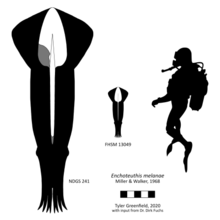Enchoteuthis (meaning "spear squid") is an extinct genus of large enchoteuthine cephalopod that lived during the Cretaceous. Although it and its relative Tusoteuthis are often compared to squid, both are now thought to be more closely related to modern octopuses. Examination of gladius remains initially yielded an estimated mantle length about 2 m (6 ft 7 in) based on specimen once described as Tusoteuthis longa, close to or equal to that of the modern giant squid, although reclassification of this genus as a muensterelloid results in a much shorter total length, about 3 m (10 ft). Three species are currently recognized as valid: E. melanae, E. tonii, and E. cobbani.[5]
| Enchoteuthis Temporal range:
| |
|---|---|

| |
| Reconstructions of the holotype and largest specimen based on Muensterella and Dosidicus | |
| Scientific classification | |
| Kingdom: | |
| Phylum: | |
| Class: | |
| Order: | |
| Suborder: | |
| Superfamily: | |
| Family: | |
| Subfamily: | |
| Genus: | †Enchoteuthis
Miller & Walker, 1968[1] |
| Type species | |
| †Enchoteuthis melanae Miller & Walker, 1968
| |
| Other species | |
| |
| Synonyms[5] | |
| |
Etymology
editThe generic name Enchoteuthis is derived from the Greek enchos ("spear") and teuthis ("squid").[1] The specific name melanae honors Melanie Bonner, who discovered the holotype.[1] E. cobbani is named after William Cobban.[2]
Distribution
editE. melanae and E. cobbani are both known from the Late Cretaceous Western Interior Seaway of North America, with specimens found in Kansas, Wyoming, South Dakota, North Dakota, and Manitoba.[2][5] E. tonii is known from the Early Cretaceous Eromanga Seaway of Australia.[3][5] An additional unnamed species is known from the Late Cretaceous Paleo-Pacific Ocean of North America, specifically British Columbia and Alaska.[5][6]
See also
editReferences
edit- ^ a b c Miller, H.W.; Walker, M.V. (1968). "Enchoteuthis melanae and Kansasteuthis lindneri, new genera and species of teuthids, and a sepiid from the Niobrara Formation of Kansas". Transactions of the Kansas Academy of Science. 71 (2): 176–183. doi:10.2307/3627369. JSTOR 3627369.
- ^ a b c Larson, N.L. (2010). "Fossil coleoids from the Late Cretaceous (Campanian & Maastrichtian) of the Western Interior". Ferrantia. 59: 78–113.
- ^ a b Wade, M. (1993). "New Kelaenida and Vampyromorpha: Cretaceous squid from Queensland". Memoirs of the Association of Australasian Palaeontologists. 15: 353–374.
- ^ Green, R.G. (1977). "Niobrarateuthis walkeri, a new species of teuthid from the Upper Cretaceous Niobrara Formation of Kansas". Journal of Paleontology. 51 (5): 992–995.
- ^ a b c d e Fuchs, D.; Iba, Y.; Heyng, A.; Iijima, M.; Klug, C.; Larson, N.L.; Schweigert, G. (2020). "The Muensterelloidea: phylogeny and character evolution of Mesozoic stem octopods". Papers in Palaeontology. 6 (1): 31–92. Bibcode:2020PPal....6...31F. doi:10.1002/spp2.1254. S2CID 198256507.
- ^ "YPM IP 038058". Yale Peabody Museum of Natural History. n.d. Retrieved 31 March 2021.